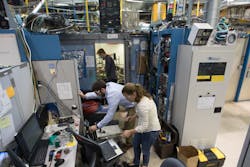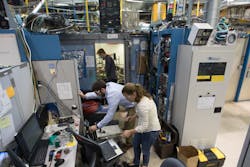Researchers Use X-Rays to Explore 3D Printing with Metal
Scientists at the Department of Energy’s SLAC National Accelerator Laboratory are using X-ray light to observe and understand why the process of 3D printing metal parts leaves flaws in finished parts and how those flaws can be avoided. The aim is to help manufacturers build more reliable parts whether in a factory, on a ship or plane, or even remotely in space, and do it more efficiently.
“Theoretically, 3D printing can be a quick turnaround, simply design, send, print from a remote location,” says SLAC staff scientist Johanna Nelson Weker, who is leading the project. “But we’re not there yet. We still need to figure out all of the parameters involved in making solid, strong parts.”
Currently, companies such as General Electric and Boeing build metal parts with 3D printing, but each part and 3D printer must pass vigorous qualifications. If 3D printing were better understood and could reliably prints flawless parts, the need for qualification testing would diminish and manufacturing costs could come down.
SLAC staff scientist Johanna Nelson Weker, front, leads a study on metal 3D printing at SLAC’s Stanford Synchrotron Radiation Lightsource with researchers Andrew Kiss and Nick Calta, rear. (Dawn Harmer/SLAC)
3D printing metal often results in pits or weak spots when the metal cools and hardens unevenly while building up the layers. In the SLAC X-ray experiments, scientists are analyzing every aspect of the printing process, including the kinds of metal used, the laser’s heat level, and the speed at which the metal heats and cools. They want to find the best combination of these parameters for eliminating pits, controlling the microstructure, and manufacturing strong metal parts.
Until recently, researchers watched from above as layers were created and added to form parts. But they couldn’t see below the surface of the metal, so it was impossible to tell how deeply the laser was melting the layers as each one was applied. They tried using IR imaging on the layers, but this did not give them much information on what was causing weak spots. X-rays, however, proved to be an excellent way to see and record what’s happening inside parts as they’re being built.
SLAC researchers use two X-ray methods to see what happens during metal 3D printing. With one type of X-ray light, they create micron-resolution images of what happens as the layers of metal build up. The second method bounces X-rays off the atoms in the material so they can analyze the atomic structure as it changes from solid to liquid and back to solid during the melting and cooling process.
Thus far, the group has been looking at lasers hitting layers of metal powder, but they also plan to investigate another approach called “directed energy deposition.” In this 3D printing technique, a laser hits and melts metal powder or wire as it is laid down, allowing creation of more complex geometric forms. This sort of 3D printing is especially useful for making repairs. The researchers also plan to incorporate high-speed cameras into their experiments so they can photograph and video the printing process and correlate what they see with their X-ray data.
This is important to manufacturers and other researchers who use cameras to observe the process but don’t have access to an X-ray synchrotron, Weker says: “We want people to be able to connect what they see on their cameras with what we are measuring here so they can infer what’s happening below the surface of the growing metal material. We want to put meaning to those signatures.”

